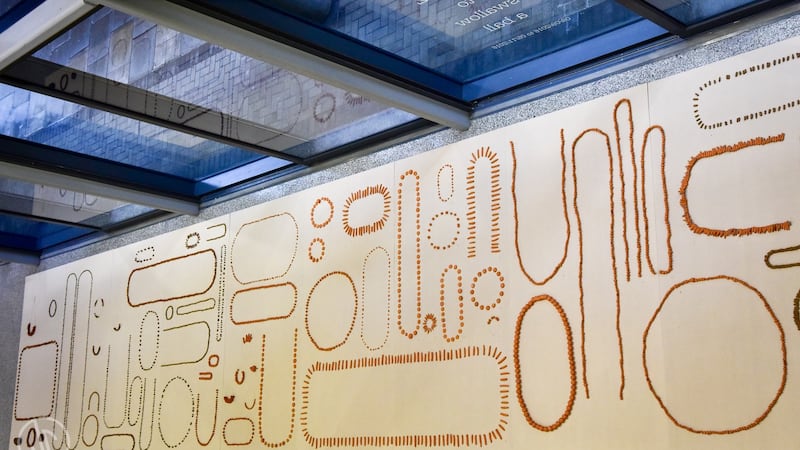To Swallow a Ball – Vanessa Donoso López The Lab, Dublin
*****
There’s a temporary air to Vanessa Donoso López’s show at The Lab. Appropriately so given its underlying concern with the way that process, flow, movement and change coexist with and ultimately win out over rootedness, identity and fixity. Clay is the predominant material throughout, handled very simply and directly, kneaded into beads, moulded into pots and platters and other rudimentary forms.


It comes from several sources, rural and urban, including Avoca and Ballinaclash in Co Wicklow, Belalcázar, Cordoba in the south of Spain, Santa Ponça on Mallorca, Bull Island, Foley Street adjacent to The Lab, and the Firestation Studios nearby. The artist drew groups of people, children and adults, into working with clay at the various locations. Each clay has its own character and properties. Colour and texture vary considerably depending on mineral content and whether and to what extent it is fired and, perhaps, glazed.
Clay is specific to place, but it is also universal. We know immediately what it is and what it feels like: it’s as tactile a material as you can imagine. And we know its extraordinary usefulness, decorative and functional. Here, using it metaphorically, Donoso López refers to its Bronze Age role as a medium for writing in the form of clay tablets, inscribed with cuneiform script by the use of sharpened reed stems.
Skinless serpent
At the end of the gallery a theatrical installation occupies a darkened room. It visualises an episode from the Epic of Gilgamesh, the earliest surviving literary work, which was written on clay tablets. Following the death of his friend Enkidu, Gilgamesh searches for the secret of eternal life. Eventually finding a rejuvenating plant, he momentarily sets it aside to bathe, whereupon it is snatched by a serpent who sheds it skin and departs. Life, it is implied, must be lived. The skinless serpent that slithers away is composed of multiple ceramic discs.
In the main gallery space, myriad clay beads and pieces are arranged in simple patterns on oblong sheets on the ground. Discreet labels recall museological display, as though they are archaeological exhibits, and specify the origin of each piece. The forms suggest some decorative and other functions, but never too exactly. They mostly make up a series of interconnected conversations with each other, echoing, amplifying and extrapolating patterns as you move through the space. They flow.
On the mezzanine space above, two vast table tops are densely laid with ceramic plates and bowls, each piece painted with a layer of a different clay, engendering great variety of colour and texture. It’s like a feast, a gathering, drawing together and mixing all the individual clays arranged below. Donoso López, who is from Barcelona but has been based in Ireland for over a decade, has in the past made work that deals – often humorously – with themes of migration, cultural identity, nostalgia and assimilation. This show can be seen as continuing this internal debate, with an emphasis on life as an open, flexible, finite process. There is a message here for sure, one that is lightly delivered. The Lab is a difficult enough space, but its challenging levels, recesses and aspects are brilliantly used in this case.
Until November 9th, dublincityartsoffice.ie/the-lab
Inductive Probability – Paul Gregg
RHA Gallagher Gallery, Dublin
****
Aesthetic judgements, Immanuel Kant argued, involve assessing beauty as though it is purposive, even though what we are dealing with does not have an actual purpose. Paul Gregg probably doesn't have Kant in mind when he makes his elaborate, unpredictable sculptural pieces, but he certainly plays on the idea of purpose in the most functional sense and then turns it on its head. His works are usually kinds of machines or devices. Contraptions that mimic mechanical and technical means and methods of dealing with problems and tasks, they take the neat logic of cause and effect and, somewhere along the line, scramble it up, prompting us to think outside the box.
One of his best-known works, with documentation of some of the reaction it engendered (and which became part of it, really), is included in his RHA show. Reconnaissance and Delivery involved the mysterious appearance in Waterford, in 1998, of objects that seemed to have parachuted from the heavens. Cyrillic lettering on the purposeful-looking constructions suggested Russian origin. The Gardaí consulted Met Éireann and the Irish Army. Newspapers and RTÉ featured the mystery. Logical speculation led in one direction, aesthetic logic in another. The mysterious objects were created as a public art project initiated by Garter Lane in Waterford.
Heath Robinson-style
They followed on from an earlier work by Gregg in
Baltimore
,
Maryland
. On that occasion he visited 24 rockets on the city. American by birth, he studied in Los Angeles and completed an MFA in Baltimore before coming to Ireland on a Fulbright scholarship in 1995. He’s stayed since, teaches at DLIADT and works very productively as an artist. His natural artistic habitat, however, is not in the gallery but out there in the world at large. His record suggests that he likes public art projects and his mad-boffin, W Heath Robinson-style approach, backed up by conceptual flair and real technical and manual skills make him ideally suited to them.
The news coverage garnered by the new piece he created for the RHA, Mens Sana in Corpore Sano shows his ability to tap into media attention and the public imagination. It's an interactive handball alley in which the ball impacts against a grid of variably angled plywood panels so that it bounces back unpredictably. There's a clue in the markings painted on the floor of the gallery, set at an angle and even running up the wall. No matter what your level of skill, Kant is going to win this game.
Until October 23rd, rhagallery.ie
















